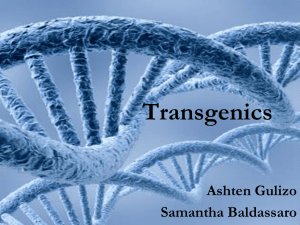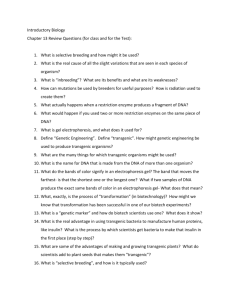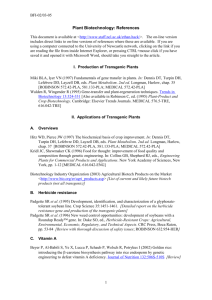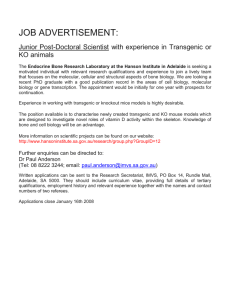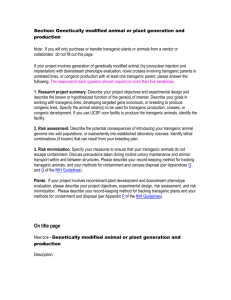Emily Mangan ANS 420 3/5/14
advertisement
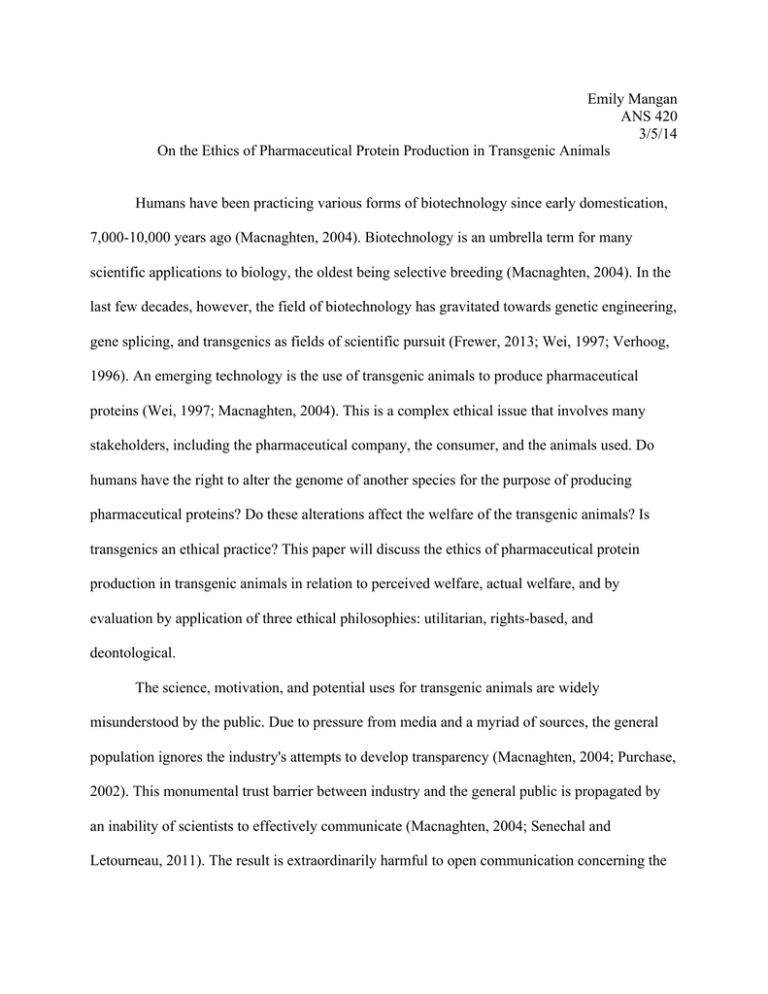
Emily Mangan ANS 420 3/5/14 On the Ethics of Pharmaceutical Protein Production in Transgenic Animals Humans have been practicing various forms of biotechnology since early domestication, 7,000-10,000 years ago (Macnaghten, 2004). Biotechnology is an umbrella term for many scientific applications to biology, the oldest being selective breeding (Macnaghten, 2004). In the last few decades, however, the field of biotechnology has gravitated towards genetic engineering, gene splicing, and transgenics as fields of scientific pursuit (Frewer, 2013; Wei, 1997; Verhoog, 1996). An emerging technology is the use of transgenic animals to produce pharmaceutical proteins (Wei, 1997; Macnaghten, 2004). This is a complex ethical issue that involves many stakeholders, including the pharmaceutical company, the consumer, and the animals used. Do humans have the right to alter the genome of another species for the purpose of producing pharmaceutical proteins? Do these alterations affect the welfare of the transgenic animals? Is transgenics an ethical practice? This paper will discuss the ethics of pharmaceutical protein production in transgenic animals in relation to perceived welfare, actual welfare, and by evaluation by application of three ethical philosophies: utilitarian, rights-based, and deontological. The science, motivation, and potential uses for transgenic animals are widely misunderstood by the public. Due to pressure from media and a myriad of sources, the general population ignores the industry's attempts to develop transparency (Macnaghten, 2004; Purchase, 2002). This monumental trust barrier between industry and the general public is propagated by an inability of scientists to effectively communicate (Macnaghten, 2004; Senechal and Letourneau, 2011). The result is extraordinarily harmful to open communication concerning the Mangan 2 benefits, detriments, and applications of biotechnologies (Macnaghten, 2004; Frewer, 2013). Because of this lack of framework, it is difficult for the layperson to make an ethical decision, yet the public does not trust academia to make ethical decisions for them. Arguments cited in favor of distrusting science often have a historical background, including agent orange, thalidomide, DDT, lead paint, and smoking cigarettes, all of which had unintended and unforeseen consequences (Macnaghten, 2004; Senechal and Letourneau, 2011). These truths illustrate that we are indeed human and make mistakes. Therefore, it is pertinent that every evaluation of the consequences of scientific application be thoroughly evaluated and the ethics scrutinized. In order to understand the motive of transgene use in animals, an appreciation of alternative methods to synthesize pharmaceutical proteins and the transgenic process itself must be constructed. Production of human recombinant proteins via bacterial cell culture is the most common method of production (Houdebine, 2009). However, production requires extensive facilities, labor, and is neither cheap nor high yielding (Houdebine, 2009; Keefer, 2004). Bacteria are also unable to synthesize complex protein structures, which are necessary to mimic endogenous human proteins (Houdebine, 2009). For example, bacteria lack the ability to perform posttranslational modifications of proteins, such as phosphorylation, gamma-carboxylation, or glycosylation (Houdebine, 2005). These modifications must be performed after synthesis by a series of carefully controlled processes to yield a viable product, and these products still may cause reactions in the patient receiving them due to their inexact replication of endogenous proteins (Houdebine, 2009; Redwan, 2009). Protein-producing cultures of animal cells are also used (Houdebine, 2009; Keefer, 2004). Animal cells are able to perform post-translational modifications to proteins, allowing Mangan 3 fewer steps after purification to arrive at an effective product (Houdebine, 2009). Chinese Hamster Ovary (CHO) cultures have been used extensively for this purpose, but production is expensive and yield is low, as is common among culture-systems (Houdebine, 2009; Wei, 1997; Keefer, 2004). The desire to utilize transgenic animals as bioreactors stems from the possibility of cheaply and efficiently producing large quantities of high-quality protein (Houdebine, 2009; Keefer, 2004) The extent to which pharmaceuticals are already being produced by transgenic animals in the current market is vastly underestimated by the public (Houdebine, 2009; Keefer, 2004). Transgenic animals through production in blood, milk, and urine are currently used to produce hormones, growth factors, blood factors, fibrinogen, monoclonal antibodies, insulin, and vaccines, among others (Houdebine, 2009; Barrera et al., 2010). The list of animals included in these productions is lengthy, but chickens, rabbits, pigs, and ruminant livestock are common (Houdebine, 2009). Furthermore, production of specific pharmaceutical proteins in the milk of transgenic goats appears to be the most popular production method (Houdebine, 2009; Frewer, 2013; Keefer, 2004). In 2009, the Food and Drug Administration (FDA) approved the use of ATryn, which is recombinant human antithrombin III produced in the milk of goats (Kling, 2009; Houdebine, 2009). ATryn is patented by GTC Biotherapeutics, a subsidiary of LFB Biotechnologies, and currently has four additional products in clinical trials, all of which are also produced in the milk of transgenic goats (Kling, 2009; Houdebine, 2009). ATryn is significant because it is the first pharmaceutical product produced by transgenic animals that has been approved for use by the FDA and the EMEA (Kling, 2009; Houdebine, 2009). This herd of ATryn-producing goats was created using microinjection (GTC, 2012). The nuclei of single-celled goat embryos were injected with a human gene coding for antithrombin Mangan 4 III along with a carrier that inserted this gene (Houdebine, 2009). Through homologous recombination, the inserted protein will now be produced in the milk of the transgenic goat. The success rate for this procedure is estimated to be between 2-3% (Keefer, 2004). The goats that adequately displayed the desired trait are then propagated via somatic cell nuclear transfer–a form of cloning–and sexual breeding to create a seed herd (GTC, 2012). These animals are then bred and milked with commercial equipment like an ordinary dairy goat (GTC, 2012). The welfare of transgenic animals is another facet requiring evaluation. According to Bernard Rollin, there should always exist a conservation of welfare, such that animals altered via selective breeding or otherwise should never experience a lower level of welfare than their unaltered conspecifics due to their altered genetics (1997). In the case of the ATryn-producing goats, the welfare appears to be synonymous with any commercial diary herd (GTC, 2012). The housing, feed, treatment, and other conditions between a transgenic milking goat and a native milking goat are virtually the same (Kling, 2009; GTC, 2012). According to GTC Biotherapeutics in 2012, the first ATryn transgenic goats produced in 1993 are still alive and doing well (2012). The herd has not suffered any illness uncommon for the average of the breed, age, and use of the goats (GTC, 2012). However, let it be mentioned that this is a self-report by GTC Biotherapeutics and conflict of interest may be present. Because these goats are not only private property, but also under patent law, finding reliable, unbiased information is difficult. Not all transgenic animals pass the Rollin's conservation of welfare principle, however. Production in milk appears to inflict the least amount of harm on the animal, whereas animals engineered to produce proteins in their blood tend to be physically affected by the protein production (Houdebine, 2009). It has been observed that detrimental effects may be related to specific proteins, and therefore the welfare of the transgenic animal appears to be partially Mangan 5 dependent on both the method of production and the specific protein being produced (Houdebine, 2009). According to a Swedish study conducted in 2002, 36% of transgenic animals developed unforeseen clinical symptoms due to genetic modification (Nordgren and Röcklinsberg, 2005). Beyond accidental symptoms, some transgenics have been created specifically to display debilitating genetic diseases suffered by humans (Macnaghten, 2004; Schuppli, et al., 2004; Kues and Niemann, 2004). There is a strong desire in the scientific community to develop effective treatment for these diseases, and it is difficult to study these illnesses and responses to treatment in a standard laboratory environment (Macnaghten, 2004; Kues and Niemann, 2004). To aid in the research for these genetic diseases and those who suffer from them, strains of laboratory rats have been developed using human gene insertion and gene deletion, also called knockout (Macnaghten, 2004; Schuppli, et al., 2004; Kues and Niemann, 2004). These induced diseases include various forms of cancer, diabetes, Crohn's disease, renal failure, and neurodegenerative disorders, such as spongiform encephalopathies (Kues and Kiemann, 2004). The symptoms of these diseases are numerous and lead to death or humane destruction (Kues and Kiemann, 2004). The welfare of these animals, engineered to experience genetic disorders, is objectively lower than that of their native counterparts (Macnaghten, 2004; Houdebine, 2009; Schuppli, et al., 2004). This violates Rollin's conservation of welfare principle, and therefore, it is important to note that all biotechnology applications must be reviewed on an individual basis in relation to the welfare of the animals involved (Rollin, 1996; Frewer, 2013). Another concern in relation to transgenic animal welfare is the concept of escape and interbreeding (Purchase, 2002; Vàzquez-Salat, et al., 2012). The fact that humans have engineered many of our common livestock–that we also use for food–compounds the problem Mangan 6 (Frewer, 2013). Any cross-contamination, unintended breeding, or gene transfer could have detrimental effects on the pharmaceutical and livestock industries and health effects on consumers of contaminated products (Frewer, 2013; Vàzquez-Salat, et al., 2012). While the risk of this occurring is low, the perceived risk is quite high, and further development of transgenic animals may affect international trade as many counties do not approve of genetic engineering biotechnologies (Frewer, 2013; Purchase, 2002). Though the acceptance of technologies by other countries has no impact on the welfare of the animal, possible market implications of genetic manipulation are great and should be considered in any transgenic program. While welfare can be scientifically determined, whether the welfare is acceptable or not is a matter for ethical theories (Purchase, 2002). There are four ethical principles which can guide ethical decisions: beneficence, non-malfeasance, autonomy, and justice (Purchase, 2002). However, these principles do not provide an avenue for discovery of solutions when conflicts arise (Purchase, 2002). Therefore, this paper will utilize the two moral theories–utilitarian and deontological–to approach ethics in welfare. While other moral theories do exist, these theories have long been disproven in that animals do require moral consideration (Purchase, 2002; Verhoog, 1996). From a utilitarian standpoint, one must consider all the parties involved and decide on the path that brings the least harm for the greatest benefit (Purchase, 2002). The sum of the outcomes of all actions is the deciding factor in whether or not a deed is ethically acceptable (Purchase, 2002). In order to be able to evaluate issues with this theory, the projected harm done must be accurately assessed, as must be the potential benefit. In the case of ATryn production in transgenic goats, do the potential harms of genome alteration, escape and interbreeding, and unforeseen impacts for the health of the goat outweigh the benefits of cheap and efficient Mangan 7 production of life-saving drugs? This theory leaves more questions than it answers, and it appears that the approval of transgenics should be evaluated on a case-by-case basis (Frewer, 2013). Rights-based ethics focuses on the rights individuals possess (Purchase, 2002). This could be applied to the rights of animals as well as the rights of human beings (Purchase, 2002). Do animals have the right to live their lives unadulterated? Humans often view themselves as controllers of nature, dominators of land (Purchase, 2002). Do the rights of humans to alter their environment trump the rights of animals to possess their native genetic codes? This theory also leaves an uncertain conclusion. Rights-based ethics does not select a path based on a weighing of the benefits and detriments like utilitarianism does. Therefore, either the animal possesses the right to their genome, or humans have the right to alter it, not both (Purchase, 2002). Deontology is sometimes referred to as duty-based ethics (Purchase, 2002). According to this theory, actions are inherently right or wrong (Purchase, 2002). There is no consideration of the outcomes or the weighing of the benefits against the detriments. Deontology is focused on what a society deems acceptable or unacceptable, relying on social ethics (Purchase, 2002). There is an ideal that ethics should dictate how every human should act, such that the world is in agreement in the rightness or wrongness of an action (Purchase, 2002). Due to the many contrasting points of view on the use of biotechnologies within and outside of the United States, it seems that genetic engineering should either be highly regulated or not practiced, as it is not acceptable in all cases. Transgenic animals hold enormous potential for research and production. There are limited methods to study genetic illnesses in controlled environments, and the use of transgenics have greatly improved disease research (Houdebine, 2009). However, these animals are usually Mangan 8 kept in confined populations and strictly monitored (Houdebine, 2009). Transgenic livestock for the purpose of production are kept in larger numbers than needed for research, and are housed as standard livestock, outside, with less containment and a greater chance of escape and interbreeding (Kues and Niemann, 2004; Robl et al., 2007). The lack of containment may lead to accidental genetic transfer into unaltered breeding lines, as well as distrust of the United States agricultural industry by nations importing U.S. foodstuffs (Macnaghten, 2004). It is clear that when evaluating the use of transgenics, a balance must exit between a continuation of research and the scientific method, the implications and effects on the animals involved, and social acceptance of the practice (Senechal and Letourneau, 2011). Communication between industry and the populace is paramount (Macnaghten, 2004). While it is important for the public to understand the desires and methods applied in the creation and use of transgenic animals, it is equally important that industry listen to the concerns of the people. The scientific field advances in fits and starts, breakthroughs interspersed with setbacks (Macnaghten, 2004). As humans reap the benefits from scientific developments, so too are we dealing with the unforeseen consequences (Frewer, 2013). The same company advocating the use and acceptance of rBST in dairy cattle is also responsible for eleven Superfund sites across the United States (EPA, 2014; Dohoo et al., 2003). It is clear why there is a distinct distrust of transgenic industry, and it is impossible to guarantee that mistakes will never be made again. When industry desires to implement irreversible alterations of genetic code for the sole purpose of efficiency of production and convenience for the producer, distrust is not astray. The possible implications of using transgenic animals for pharmaceutical protein production, including disease, world trade disruptions, and ecological harm, are huge. Therefore, due to the inherent welfare concerns with transgenesis in living animals and the possible damage Mangan 9 to the global market, transgenic research should be approved only on a case-by-case basis, and the use of transgenics for production of foodstuffs or pharmaceuticals should be discontinued. Mangan 10 Literature Cited Barrera, M., O. Sánchez, O. Farnós, M. P. Rodríguez, P. Domínguez, H. Tait, M. Frías, M. Ávila, E. Vega, and J. R. Toledo. 2010. Early onset and long lasting protection in pigs provided by a classical swine fever E-2 vaccines candidate produced in the milk of goats. Vet Immunol Immunopathol. 133:25-32. Dohoo, I. R., K. Leslie, L. Dexcôteaux, A. Fredeen, P. Dowling, A. Preston, and W. Shewfelt. 2003. A meta-analysis review of the effects of recombinant bovine somatotropin. Can J Vet Res. 67:241-251. Frewer, L., G. Kleter, M. Brennan, D. Coles, A. Fischer, L. Houdebine, C. Mora, K. Millar, and B. Salter. 2013. Genetically modified animals from life-science, socio-economic and ethical perspectives: examining issues in an EU policy context. N Biotechnol. 30:447460. Houdebine, L. 2009. Production of pharmaceutical proteins by transgenic animals. Comp Immunol Microbiol Infec Dis. 32:107-121. Houdebine, L. 2005. Use of transgenic animals to improve human health and animal production. Reprod Domest Anim. 40:269-281. Keefer, C. L. 2004. Production of bioproducts through the use of transgenic animal models. Anim Reprod Sci. 82-83:5-15. Kues, W. A., and H. Niemann. 2004. The contribution of farm animals to human health. Trends Biotechnol. 22:286-294. Macnaghten, P. 2004. Animals in their nature: A case study on public attitudes to animals, genetic modification and "nature." Sociology. 38:533-551. Nordgren, A., and H. Röcklinsberg. 2005. Genetically modified animals in research: an analysis of applications submitted to ethics committees on animal experimentation in Sweden. Anim Welf. 14:239-248. Purchase, I. F. 2002. Ethical issues for bioscientists in the new millennium. Toxicol Lett. 127:307-313. Redwan, E. 2009. Animal-derived pharmaceutical proteins. J Immunoassay Immunochem. 30:262-290. Robl, J. M., Z. Wang, P. Kasinathan, and Y. Kuroiwa. 2007. Transgenic animal production and animal biotechnology. Theriogeniology. 67:127-133. Rollin, B. 1996. Bad ethics, good ethics, and the genetic engineering of animals in agriculture. J Anim Sci. 74:535-541. Mangan 11 Schuppli, C., D. Fraser, and M. McDonald. 2004. Expanding the three Rs to meet new challenges in human animal experimentation. Altern Lab Anim. 32:525-532. Senechal, J., and L. Letourneau. 2011. Sorcerer's apprentice or irresponsible technician: what is the role of the scientist in the biotechnology era? Int J Sci Soc. 2:73-82. Vàzquez-Salat, N., B. Salter, G. Smets, and L. Houdebine. 2012. The current stage of GMO governance: Are we ready for GM animals? Biotechnol Adv. 30:1336-1343. Verhoog, H. 1996. Genetic modification of animals: Should science and ethics be integrated? Monist. 79:247-264. Wei, L. 1997. Transgenic animals as new approaches in pharmacological studies. Annu Rev Pharmacol Toxicol. 37:119-141. EPA. 2014. Search superfund site information. http://cumulis.epa.gov/supercpad/cursites/srchrslt.cfm?start=1&CFID=12315215&CFTO KEN=80803421&jsessionid=e0302a03bee945308b2d615744979155a332 Accessed Feb. 27, 2014. GTC Biotherapeutics. 2012. Update on the first cloned goats. Nat Biotechnol. 30:229-230.


